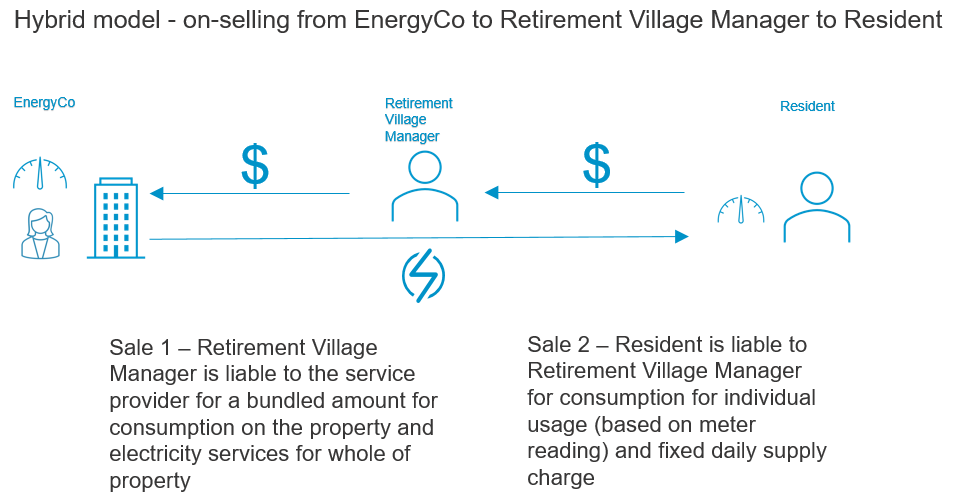These case studies are examples of typical business models that Energy Policy WA understands are being used in embedded networks in Western Australia, and that may fall under the Voluntary Embedded Networks Code of Practice. They are not representative of all business models used and are not to be relied on to understand how any specific embedded network is operated.
The manager of a retirement village has engaged a third party, EnergyCo, to operate and manage the embedded network. The retirement village manager manages any electrical work on the internal wiring, and owns the embedded network infrastructure (internal wiring, meters, and any distributed energy resources (DER) such as solar, batteries and/or electric vehicle chargers). EnergyCo is contracted to install, maintain and manage the meters and DER, and to supply electricity to the site.
EnergyCo procures electricity from the main grid at the master meter for the retirement village as well as generating solar electricity on-site. EnergyCo charges the retirement village manager a bundled rate for electricity supply and providing electricity management services. The retirement village manager does not have visibility into the price paid by EnergyCo for electricity at the master meter.
The retirement village manager is responsible for on-selling electricity to retirement village residents, as part of its existing relationship with the residents. The retirement village manager has chosen to offer residents a quota of free energy each day to share the benefits of the solar panels. The price for all other units of electricity consumed, as well as the daily supply charge, are set by the retirement village manager with reference to Synergy’s regulated residential tariff.
The retirement village manager bills residents for electricity, with residents being also able to access more detailed consumption information through an EnergyCo app.
Residents may contribute to the costs of electricity for common areas through their retirement village recurrent charges, depending on the legal structure, ownership model and financial model used for the village.
Who should register as the ENS under the Voluntary Embedded Networks Code?
EnergyCo would be the embedded network seller (ENS) by default, as it holds the contract to purchase electricity at the master meter for the embedded network.
However, the retirement village manager and EnergyCo may agree to nominate the retirement village manager to be the ENS (see clause 2.3 of the Voluntary Embedded Networks Code).
Why?
- Although the retirement village manager does not have the contract at the master meter, it sets the electricity price paid by residents of the retirement village (this could involve a mark‑up on, or different pricing structure to, the electricity price paid by the retirement village manager to EnergyCo).
- The retirement village manager may prefer to be the ENS as it has established relationships with its residents and is best placed to manage any electricity complaints/disputes in the first instance.
- The retirement village manager manages billing and other elements of the customer relationship that are unrelated to electricity (e.g. internet and water).
Whether EnergyCo remains the ENS or the retirement village manager nominates to be the ENS, the contract between EnergyCo and the retirement village manager should be structured to ensure the ENS is able to fulfil its obligations (e.g. that meters are read at suitable intervals).
Voluntary Embedded Networks Code of Practice




